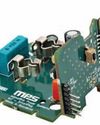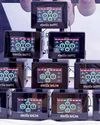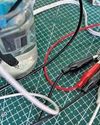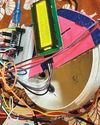Prøve GULL - Gratis
REMOTE CONTROL Over Internet
Electronics For You
|June 2025
Switching a device on or off from anywhere in the world is no longer a futuristic concept—it is practical and achievable using a simple Wi-Fi-enabled setup. Whether activating a surveillance camera, an air-conditioner, or a garden sprinkler, remote control opens up endless possibilities limited only by the imagination.

In this system, a computer with internet access communicates with an ESP32 Wi-Fi module connected to the target device. The ESP32, placed within the range of a local Wi-Fi network, serves as the interface. One of its I/O pins is linked to the device—in this case, an LED with a series resistor connected to GPIO4—and can be toggled remotely via a laptop or desktop.
The ESP32 operates at 3.3V logic levels, meaning its high output corresponds to 3.3V and all inputs must comply with the same voltage standard. Fig. 1 shows the author’s prototype. The required components are listed in the Bill of Materials table.
Circuit diagram
Fig. 2 shows the circuit diagram for the remote control over internet system. It is built around an ESP32 board (MOD1) and a few other components. The ESP32 board features 2.4GHz dual-mode Wi-Fi and Bluetooth, powered by a dual-core processor, and is connected via a USB cable.
The ESP32 can be powered either through the USB cable (typically used while uploading the code) or via the Vin pin by supplying a regulated voltage between 5V and 12V. It is advisable to use a voltage close to 5V to minimise power dissipation in the onboard voltage regulator. Power should not be supplied through both the USB and Vin pin simultaneously, as this may damage the board. (Note: A convenient way to power the ESP32 is by using a power bank with a USB port.)
 Software
SoftwareIn this setup, two nodes are required—one running on the ESP32 device and the other on the client side, developed in C.
ESP32 Installation.
Denne historien er fra June 2025-utgaven av Electronics For You.
Abonner på Magzter GOLD for å få tilgang til tusenvis av kuraterte premiumhistorier og over 9000 magasiner og aviser.
Allerede abonnent? Logg på
FLERE HISTORIER FRA Electronics For You
Electronics For You
How AI Tools Are Making SOFTWARE DEVELOPMENT BETTER
AI is reshaping how we code, debug, and collaborate. From Copilot to automation, it is changing software development in ways worth exploring.
3 mins
December 2025

Electronics For You
5 Interesting Reference Designs FOR SMART HOMES
Smart home devices are transforming the way people interact with their appliances. They make homes more convenient, secure, and energy-efficient. From smart plugs and energy monitors to smart locks and thermostats, reference designs help design engineers create connected products that are easy to use, consume less power, and are reliable. These designs allow you to control devices remotely, track energy use, extend battery life, and automate routines. They provide practical solutions for upgrading homes and small commercial spaces without major modifications.
3 mins
December 2025

Electronics For You
Fancy USB LED VASE
This USB LED vase is a simple yet elegant device that fuses art with electronics to create a decorative lighting display. Powered directly from a standard USB port, it uses readily available components such as MOSFETs, resistors, capacitors, and LEDs to produce a striking, dynamic sequence of lights.
3 mins
December 2025

Electronics For You
"WHAT OTHERS SELL IN FOUR BOXES WE BUILT IN ONE"
Years of custom field work are shaping a product line with its own cloud, its own hardware, and a market that is now beginning to recognise its value.
8 mins
December 2025

Electronics For You
BUILD LARGE LANGUAGE MODELS
Large language models are machine learning models designed for a range of language-related tasks such as text generation and translation. Here’s how open source software can help you build your own large language model.
6 mins
December 2025

Electronics For You
Rare Earth Or Rare Ingenuity? India Remains Between The Two
With China firmly controlling rare earth exports, India confronts a critical moment in its technological trajectory.
8 mins
December 2025

Electronics For You
Miniature IoT WATER TDS And LEVEL MONITOR Cum CONTROLLER
For setups that rely on stored water, clear awareness of tank level and water quality is essential. Traditional level monitors are often bulky offline devices with only simple LED indicators, while many newer smart models can be expensive and still ignore key quality parameters such as total dissolved solids (TDS) and turbidity. As environmental contamination increases, continuous monitoring of both water level and purity has become necessary.
2 mins
December 2025

Electronics For You
"Not Only Do You Get Versatile And Affordable Hardware, But You Also Gain Access To A Vibrant And Supportive Community"
What does it take to turn an idea into a working loT solution? How can academic programmes give students hands-on skills that industry actually values? Vidushi Saxena spoke with Dr Umesh Dutta to uncover how Arduino and Manav Rachna are bridging the gap between learning and real-world innovation.
3 mins
December 2025

Electronics For You
5G + SATELLITES: The New Frontier Of Global Connectivity
The fusion of 5G and satellite networks is transforming communication, from remote villages to skies above. By merging 5G’s speed with satellites’ reach, engineers are creating a seamless global web that erases ‘no signal’ zones. This convergence is bridging the digital divide and redefining connectivity as a universal promise, not a privilege.
6 mins
December 2025

Electronics For You
SMART ECOBIN For Safer Environment
The Smart EcoBin is an intelligent waste management system designed to promote environmental sustainability and improve the efficiency of waste collection.
4 mins
December 2025
Listen
Translate
Change font size
